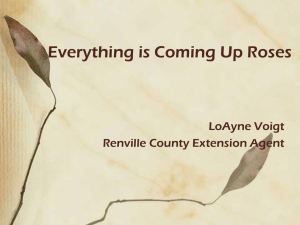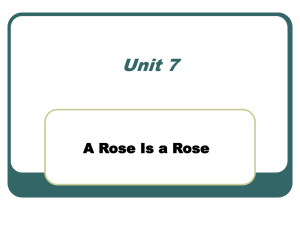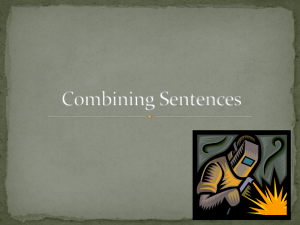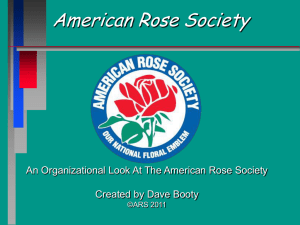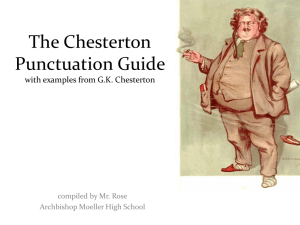Answer - Master Gardeners
advertisement
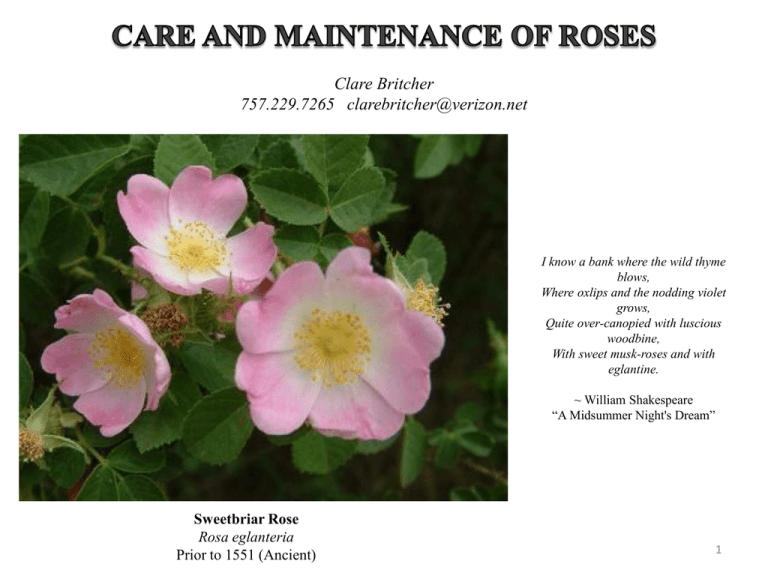
Clare Britcher 757.229.7265 clarebritcher@verizon.net I know a bank where the wild thyme blows, Where oxlips and the nodding violet grows, Quite over-canopied with luscious woodbine, With sweet musk-roses and with eglantine. ~ William Shakespeare “A Midsummer Night's Dream” Sweetbriar Rose Rosa eglanteria Prior to 1551 (Ancient) 1 Growing Roses In And Around Williamsburg Why growing roses here isn’t always such a bed of roses… Roses need: Sun-at least 6* direct (full blast) hours per day Soil-well drained, fertile, rich, neutral pH Adequate water, supplied regularly Good air circulation A moderate climate-not too hot, cold, or humid We have: Lots of shade-woodlands grow best here Soil-heavy clay, infertile, acidic Landscape Rose “Scarlet Meidiland’ Droughty summers (except for hurricanes/Nor'easters) Normally very calm winds (except for hurricanes/Nor'easters) Hot, humid summers with moderate winters Oh, and did I mention that we also have: Fungal diseases aplenty Japanese Beetles Voles-moles don’t eat roses: they are insect eaters (no veggies!) Deer *A rule of thumb is that species and Hybrid Musk roses are ‘shade tolerant.’ For a list of roses that can tolerate ‘shade’ (3-4 hours of direct sun per day): http://www.antiqueroseemporium.com/groups/partial-shade. English 2 Roses (David Austin) are said to be shade tolerant, too. Roses can be grown successfully here, if you understand a few important things about roses. And human nature. The flowers of roses are legendary. They symbolize love, royalty, beauty, magic, fragrance, medicine, and even religion. Because of the many attributes of rose flowers, people wanted to grow and perfect (hybridize) them as far back as the ancient Chinese and Roman Emperors. In response to demand, rosarians through the ages selected roses based on blooms: size, color, perfume, repeat, etc., often at the expense of all else, including plant form and vigor. The roses may have changed, but people’s expectations have not. People generally have high expectations, and grow roses for their flowers. And herein lines the problem… Roses are not flowers. Roses are flowering shrubs. To grow roses successfully, you have to understand the nature (genetics) and the nurture (cultural requirements) of the shrub. 3 As a Master Gardener, the public will contact you to get help with problems they have in growing their roses. Think of it as an “Ask A Nurse Hotline” for plants. A general understanding of roses is important to ferret out symptoms and information from the client, which will lead you to a diagnosis and recommended solution. The Extension Office will have a ‘Master Blaster’ book of chemicals/commercial preparations that are effective for controlling diseases and pests. These are official recommendations from VaTech. You will learn about chemical treatments as a separate part of your Master Gardener training. There are some organic and/or low environmental impact alternative remedies that will likely work, too. These are unofficial, sometimes anecdotal, and will be discussed in this lecture, just for the heck of it. (After all, some folks want an alternative to chemicals.) If all else fails in helping to resolve an inquiry, The Richmond Rose Society www.richmondrosesociety.com has consulting rosarians who will troubleshoot problems for the public. Their website is an excellent resource. It also lists roses that perform well in our area, offers information about rose culture, lists reputable rose nurseries, etc. The Lewis Ginter Botanical Garden in Richmond has an excellent rose demonstration garden that includes antique roses as well has modern hybrids and landscape varieties. 4 Roses can be grown either as "grafted” or “own root.” Hybrid Teas, Floribunda, Grandiflora, and English roses are normally grafted onto vigorous Old Garden Rose (Antique) or Species (wild) rootstock. Hybrid Tea ‘Peace’ Long stems with large solitary high-centered flowers Floribunda ‘Iceberg’ Stems with clusters of smaller flowers Grandiflora ‘Queen Elizabeth’ Long stems, large flowers, in clusters, on a big shrub English Rose (David Austin) Old rose form/modern colors ‘Abraham Darby’ Old Garden (Antique), Species (found/wild), and Shrub (Landscape) roses are grown on their own vigorous roots, usually from cuttings. Bourbon ‘Souvenir de la Malmasion’ 1843 China species Mutabilis Prior to 1894 (Ancient) Modern Landscape Rose ‘Knockout’ 5 Let’s explore some likely example questions about growing roses in and around Williamsburg that you may encounter as a Master Gardener, and offer some possible explanations and solutions. There is no way we can cover every question with which you may be faced, but this will be a start. And remember, even the most experienced gardeners look things up: they do research, because they know that new knowledge and technology can change things on a dime. 6 Question: Can I just dig a hole and toss the rose in like the crepe myrtle trees that I buy from Home Depot? Answer: Sorry, but no cigar. Roses are gross feeders and correct preparation and planting can mean the difference between success or failure. Container grown roses can be planted as long as the ground isn’t frozen and around here, that’s all year long. Here’s how I do it: dig a generous hole in sunny spot with well-drained soil, not too close to tree roots. If the soil does not drain well, create a raised bed or mound. Into half the clay soil that was dug out of the planting hole, mix in generous amounts of composted horse manure and either Permatill or gravel; (the Permatill/gravel will encourage drainage and discourage voles); add three cups of Espoma Plantone, and a couple of big handfuls of lime. (Note: you should advise people to get a soil test so they know how much lime to use!) These ingredients are mixed into half the soil that has been dug out of the hole: add enough compost so that the amended mixture will now fill the hole. Add one-half of the amended soil back into the hole. A cone of soil is created in the hole if the rose is being planted bare root to support the roots. Add enough soil to cover the roots, then fill the hole with with water from a hose to remove any air pockets. If grafted, I plant with the bud union either at ground level or slightly below, to keep the rose from being blown over in high winds. Add the remaining amended soil to the hole and tamp down. The leftover unamended clay from the hole is used to create a berm, and the rose is watered with a hose one last time to remove any remaining air pockets in the soil. Question: How much water do my roses need? Answer: Water about every third day if there is no rain, until established. After that, the 1” of water per week rule-of-thumb is fine. Soaker hoses are best or if watering with a sprinkler, water early enough in the day so the leaves and flowers can dry out: our climate is a perfect breeding ground for fungal diseases. An old recycled tuna 7 can makes a great and inexpensive rain/water gauge. Question: Should I buy bare root roses or roses growing in pots? Which is better? Answer: Depends. If you are new to roses, go to a nursery and buy a containerized rose. You will be able to look at the blooms and get expert advice, if needed. Also, nurseries tend to stock roses that will do well in our climate. Buying #1 grade bare root roses from a reliable source can cost less that containerized roses, and the varieties can be almost limitless. Bare root roses are only shipped in spring in a dormant state, so the roots must be soaked in water for several hours prior to planting. One disadvantage to bare root roses is that the rose you buy may or may not thrive in our climate: you have to do your homework ahead of time. You must also pot, plant, or heel them in within a short time after you receive them. Question: It’s just an old wives tale that you can’t plant a rose in the same place that you just dug one up, right? Answer: It is not a wives tale, it is true, and it is probably due to plant specific nematodes. It’s kind of like getting Montezuma’s Revenge when you visit a foreign country and drink the water: the E. coli in the water isn’t the same E. coli as in your gut. You can plant another rose in the same planting hole if you (1) dig out all the soil in and around the rose and replace it with amended virgin soil or (2) solarize the soil (my preference). To solarize, get a couple of heavy contractor’s black garbage bags and some garden staples. In spring cover the entire area on the ground where the rose was planted with black plastic, fasten down with garden staples, and hide the black plastic with mulch. Over the summer, the sun will cook the soil, along with the nematodes and every other living organism. In the fall, add compost to reactivate the now sterile soil and plant away. 8 Question: “My rose has weird very-dark reddish growth with a starburst of new shoots; the flowers are deformed; and some shoots do not produce flowers. What should I do? Answer: Is it possible that you accidentally sprayed Roundup too near to the rose? Nonselective herbicide overspray can cause this reaction. If not, then your plant may be infected with a virus called Rose Rosette Disease. The Virginia Cooperative Extension Division Publication 450-620 explains it in detail: the publication is available online. *Rosa multiflora is sometimes used as rootstock for grafted roses. In the past it was also planted as erosion control and is now an invasive species that engulfs meadows and pastureland. It is the kudzu of the rose world, and it is present in and around Williamsburg: you can see it growing into trees along I-64 in late spring/early summer. Rosa multiflora is a carrier for Rose Rosette Disease. There is no treatment at this time. The virus is lethal within one to two years. A mite vector can spread the disease to cultivated roses. There is at least one JCC/Williamsburg Master Gardener who recently lost a cultivated rose to this disease. Witches broom growth on infected r. multiflora, from Pub. 450-620 9 Question: “I planted a pink rose and now it is red, and the flowers are not as pretty. What is going on?” Answer: The pink rose was grafted onto red rose rootstock. The pink rose has died, and the red rootstock has taken over. Many roses are grafted onto Old Garden Rose root stock to add vigor and bloom size, and to increase production for commercial growers. Old Garden Climbing Rose Root Stock: Climbers (left) ‘Dr. Huey’ 1914 and (right) Rosa Multiflora 1866 Question: “I planted a pink rose and now it is blooming both red and pink, and the flowers are not the same. What in the samhill is going on?” Answer: The pink rose was grafted onto red rose rootstock. The red rootstock has suckered. You need to take a spade and dig up the red rose, severing the unwanted growth. (Note: In this illustration, the bud union is well below ground to protect it from extremely low temperatures. This tends to shorten the life of the rose but protects it from freezing to death.) 10 Question: When do I prune my roses? Answer: It depends on the rose. If it is grafted, prune on Valentine’s Day (February 14 th.) If it is a once-blooming rose (such as Lady Banks), prune after blooming. If the rose is on its own roots (repeat Old Garden, Landscape) it may not need any pruning at all. Question: How do I prune my roses? Answer: You need to attend one of our pruning clinics! Roses are pruned like any other shrub: remove dead, diseased, and damaged branches. All branches growing towards the inside of the shrub should be removed to promote air circulation and increase sun penetration. Prune on an angle with sharp bypass pruners, with the bud inclining in the direction you want the growth, which is always outward. Pollarding roses serves the same purpose as pollarding crepe myrtle trees: fewer but larger blooms. Roses can be pruned higher: this will increase the lifespan of the rose, but blooms will be smaller. Old and landscape roses growing on their own roots do not need pruning, except for maintenance. Many varieties of antique roses thought extinct have been rediscovered growing in abandoned cemeteries and homesteads. They should never be pollarded, but always pruned high, if at all. 11 Question: The leaves on my roses have black and yellow blotches and are falling off. What is happening? Answer: Your rose is suffering from black spot, a common fungus infection in this area. Some roses can deal with it; some cannot, and will completely defoliate. It is believed that the introduction of the yellow bloom gene from the middle east created the weakness. Prevention includes good air circulation, keeping the leaves dry, and cleaning up and destroying infected leaves. Many chemical fungicides are available, including systemic controls. I try to plant resistant roses and spray neem, if needed. Liquid copper is another organic control, but isn’t that great for aquatic life. Other organic measures that will work are spraying sulfur both on the leaves and on the ground, or spraying with compost tea and/or liquid kelp. A home-brewed spray mixture of 4 teaspoons of baking soda and a few drops of either oil or liquid dish soap works reasonably well. Organic controls need to be reapplied after rain, except for neem, which is oil-based. Question: Are any roses immune to blackspot? Answer: Rosa rugosa (species); some rugosa hybrids; and Knockout (landscape) are impervious. R. Rugosa also endures salt spray, but not chemical spraying: never spray chemicals on a rugosa-it will burn. 12 Question: Some of the blooms on my rose are not opening, and some are turning brown. What’s up? Question: The leaves on my rose are covered with white powdery stuff and are curling up. What’s wrong? Answer: Welcome to the south, the land of humidity and fungal diseases. Cool, wet weather creates perfect conditions for powdery mildew, rose balling , and botrytis blight. Prune off the balled blooms, the brown shriveled roses, and the moldy leaves, and discard—never compost diseased plant parts. These are fungal diseases like blackspot, so they are treated in the same way. You may also want to spray with neem or copper as a prevention, before the condition starts, which tends to be in the spring and fall. Some cultivars of roses are more susceptible to fungus diseases than others: the Richmond Rose Society lists roses that do well in our climate. Question: My rose is covered with tiny green bugs and a sticky substance. What can I do to get rid of the bugs and get that icky stuff off my roses? Answer: Aphids come out in droves in the spring to suck the life out of roses. Adding insult to injury, the honeydew covering the plant is the rose sap being excreted by the hungry pests. The good news: they can be controlled without chemicals. IPM (Integrated Pest Management) is perfect for controlling aphids: first, jet spray the entire plant with the hose-this will knock most of the aphids off and simultaneously wash off the honeydew. Ladybugs eat aphids. The next step up is insecticidal soap. If that doesn’t work, neem or pyrethrin will do the trick. Respray about every week, and after it rains: aphids breed like rabbits (on steroids.) 13 Question: Is there anything unique about pruning roses? Answer: Yes, there are some things you should do beyond normal pruning: You must disinfect your pruning shears with Listerine, Lysol, alcohol, etc. between rose bushes. Rose Mosaic Virus can be introduced into a garden from a rose infected by unsanitary grafting at the nursery, and it can spread between bushes in the garden through unsanitary pruning. Most roses growing on their own roots are not infected at the nursery, but can become infected by poor pruning sanitation by the gardener. Some infected roses only show yellow banding, veining, or mottling on the leaves in spring, but most infected roses are stunted and show a failure to thrive. There is no treatment. (Prune with a shovel.) After you prune a rose cane, it needs to be sealed with either Elmer’s Wood Glue or nail polish: this will create a hard seal on the cut. Unsealed canes can become an entry site for Rose Cane Borers. If the rose is already infected, prune out the dead cane until you reach healthy white tissue. Burn, crush or destroy the dead cane: there will likely be a borer inside. Leaving a stub above the bud when pruning can cause dieback or rose canker: it is caused by a fungal infection. You must remove affected canes or cut back until the tissue is white. Leaving infected canes intact can cause the rose to die. Always gather all trimmings, canes, leaves, etc. after pruning and either discard or burn them. Do not compost them, as they may contain diseases or fungus spores. Save paper sacks from the grocery store for the trimmings: the thorns from the rose canes tear the plastic trash bags. 14 Question: The new shoots of my rose are wilted, and there appear to be pin-like holes along the side of the stems. Is it a disease, and can it be treated? Answer: Your rose is the host for a wasp insect larva: rose stem sawfly. Prune off the infected canes and burn or discard them: they contain the worms that are burrowing into the rose pith. Sawflies are smaller than rose cane borers and do not need an open pruning wound to drill into your roses, but they are still borers, and your rose is the host for their larvae. Question: The rosebuds on my rose are not opening and those that do are deformed with brown gashes. Should I spray my rose and if so, with what? Answer: Your rose is infested with thrips. Unlike balling or botrytis blight, you will be able to see the feeding damage. Prune off the infected buds and blooms and discard or burn them. Then spray the rose with neem or pyrethrin. Note: Thrips, rose balling, and botrytis all look pretty similar. Pruning the affected blooms and spraying with neem is the same treatment as is used for rose balling and botrytis blight (hint, hint Master Gardener trainees.) Question: It’s been hot and dry lately, and the leaves on my rose are curling and turning brown. But there also seem to be webs on the leaves. Is this a caterpillar infestation? Answer: It’s probably not caterpillars, it’s most likely spider mites. You can confirm this with the ‘white paper test.’ Take a piece if white paper and hold it under the leaves, then tap or shake the leaves. If there are small dark pinpoints moving on the paper, you will know for sure. Take a hose and wash down the plant with a jet spray. Then treat with insecticidal soap or neem. 15 Question: Help! My roses are being skeletonized by June bugs. Can I spray them with Off or do I need to buy special bug spray? Answer: Those are not June bugs, they are Japanese beetles. The Japanese beetles were accidentally introduced into this country on the east coast and have no natural predators, so they are a real problem in high summer. Treat your lawn with Milky Spore: it will last for ten years and will kill the grubs before they hatch into beetles. You can hand-pick beetles, or you can spray them with neem or pyrethrin. Japanese beetle traps are effective if placed on the parameters of your property, and not near the plants you want to protect, since a lure trap works by attracting them. Tell the client that they can spray the Off on themselves, but only if mosquitoes are a problem while they are gardening! 16 Question: My roses are listing to one side and appear to be severed at the roots, and there seem to be shallow tunnels in my lawn. (My hostas have outright disappeared!) My neighbor says moles are eating my roses and I need to put moth balls in the tunnels. Will this work? Answer: Moles do not eat roses or any other plants. They eat insects, like earthworms and Japanese beetle grubs. They are a nuisance, but they do aerate the clay lawn and will help reduce the Japanese beetle population. They stay underground and are sightless. You can trap them, if you wish. Your problem is with voles (field mice). They only eat plants, like roses and hostas. They too make tunnels, so they can move around and chomp on roots. Their natural predators are snakes, raccoons, owls, and hawks. They breed like insects, but you can fight back. Domestic cats are natural vole hunters. Incorporating Permatill or sharp gravel into the planting hole with a rose is effective. The nuclear option is Ramik Green, a highly effective poison peanut. Make a hole in the tunnel from the top (a stick will do) drop in a couple of peanuts, then seal the hole with your foot. Do this in several places and in several tunnels. Wear gloves and be careful to bury the peanuts lest the birds or your pets find them. If you have voles, you have to declare war on them, and failure is not an option. 17 Question: We just moved here, and deer are eating my roses (and a whole lot of other stuff, too.) I am tired of feeding the deer with my roses. What is the easy way to get rid of them? Help! Answer: The deer were here long before subdivisions, and we have eliminated their natural population growth regulator, wolves. Deer don’t just eat plants, they can spread disease-carrying deer ticks into our environment, too. Unless you are a hunter with a taste for venison, prevention equals a whole lot of pounds of cure. Once the deer start to chomp your plants, they will come back: they do whatever is easy to get a meal--this is deer behavior. If you make it hard for them to eat your plants, they will go away and stay away. They do not want to work any harder than they have to in order to get food. ]Put your dog on a leash (or turn him loose) and let him mark the garden as his territory. To a deer, a dog is a wolf and wolves eat deer. ]Spray Liquid Fence all along the garden parameter (not just the plants, spray the ground, the posts, the trees, etc.) to create an invisible barrier. Begin in January when the deer are scouting out the best gardens for a meal, and continue into late spring, or as needed, depending on rain. You need to respray if the equivalent of 1” of rain has fallen. Retired York County Extension Agent Jim Orband swore by Liquid Fence to keep deer at bay in his own garden. ]Plant a barrier around your roses with plants that deer will not eat, such as verbena bonariensis, catmint, rosemary, etc. Deer do not like the taste or smell of herbs. ]The nuclear option is deer fence. Conventional decorative fencing will work if it is high enough and/or if the deer do not have a clear take off and/or landing sight if they try to jump it. ]Hungry deer in times of hard winters or drought will eat anything if they are desperate enough: at these times, all bets are off—they have even been known to eat birds and small animals on occasion. 18 Question: Are any roses deer proof? Answer: Possibly…based on anecdotal evidence… Swamp Rose 1824 (Ancient) American Species Height x Width: 6’ x 6’ unpruned Bloom Color: Vivid pink Fragrance: Strong Rebloom: None: extended bloom late spring to early summer Flower: Single or double, with large golden stamens Habit: Large, few thorns, vigorous; cascading long canes; long, willow-like leaves; attractive burgundy colored canes in winter Diseases: Disease resistant; claimed to be deer resistant Notes: Native to Virginia; red hips in fall; will grow in waterlogged or normal soil; forms thickets; attractive to bees, butterflies, and wildlife; grown by Empress Josephine, wife of Napoleon Rosa Rugosa Rubra (Ancient )Japanese Species Height x Width: 5’ x 5’ unpruned Bloom Color: Red to purple Fragrance: Strong and heavy Rebloom: Recurrent, spring to fall Flower: Single, with large golden stamens Habit: Large, very thorny, vigorous; tough as nails Diseases: Disease resistant; immune to black spot; control Japanese beetles with neem or pyrethrin: do not over-spray—resents chemical sprays Notes: Native to Japan; rugosa means “wrinkled”, in reference to the leaves (which are also thorny); huge red hips in fall with gold fall leaf color; makes an impenetrable hedge; also called the “Tomato Rose” because of the hips; said to be deer resistant when established 19 Question: My climbing rose won’t bloom. What’s wrong? Answer: Is it planted in the shade? If not, how often are you pruning it? Are you deadheading it? Climbers should not be pruned every year: most do not need pruning at all. Do not prune more often than every other year. Roses grown on an upright trellis do not bloom as well as roses with bent canes: the more bend, the more blooms. (If the rose is planted with surrounding lawn, pay attention to the next question.) Question: Can I use lawn food (fertilizer) on my roses? Answer: Not unless you want to sacrifice blooms for leaves. The three numbers on the fertilizer package (N-P-K) stand for Nitrogen, Phosphorus, and Potassium. A typical chemical lawn fertilizer may be 22-2-2, a high nitrogen formula to promote leaf growth. A chemical rose fertilizer might be 18-24-16: phosphorus promotes root growth and flowers; and potassium promotes overall plant health. Do not fertilize in the fall after Halloween, or before daylight savings time begins in the spring, because the new growth it will spur can be nipped by frosts. Compost is the best thing you can “feed” to your roses, and can be top dressed at anytime of the year. Question: Is there a foolproof rose, or is that an oxymoron? Answer: Yes, there is a foolproof rose and it is called Knockout. It is a miracle of modern hybridizing—it acts more like a bullet-proof shrub than what we think of as a ‘rose.’ It thrives on neglect, is immune to blackspot, and blooms its head off. And it does not require pruning. However, Japanese beetles and deer will still eat it, and it has the vulnerabilities of any garden shrub: it is no match for extended droughts, voles, or weed whackers. There are now several varieties available, single, double, and other colors besides red. Knockout roses can vary in height from 5’ to 3’ so do your research before you buy. 20 Question: In general, what are some what are some good roses to grow here in Williamsburg? Answer: The Richmond Rose Society has an excellent list, but here goes with a few suggestions: Native American Species roses ‘Prairie Rose’ and ‘Swamp Rose’ (Swamp rose tolerates low oxygen at roots) China roses ‘Mutabilis’ and ‘Old Blush’ (Heat but not cold tolerant, ancient, great rebloom/disease resistance) Grandifloras ‘Gold Medal’ and ‘Queen Elizabeth’ Rambler rose ‘Lady Banks’ (20’ wide x 20’ high, thornless, evergreen, massive) Landscape roses ‘Carefree Delight’ and ‘Knockout’ (Do not confuse Carefree Delight with Carefree Wonder) great disease resistance/rebloom English Roses ‘Graham Thomas’ and ‘Abraham Darby’ (old rose form, very big fragrant blooms, blackspot susceptible) Floribundas ‘Playboy’ and ‘Iceberg’ Hybrid Teas ‘Double Delight’ and ‘Mr. Lincoln’ Large Flowered Climbers ‘Fourth of July’ and ‘Lace Cascade’ 21 To Summarize… To grow great rose flowers on rose shrubs you need: fertile, well drained, neutral pH soil; sufficient sun and moisture; regular deadheading (if the rose is a re-bloomer); an appropriate rose variety for our climate; and control of diseases and pests, if required. And lastly… let’s have a hands-on look at two living Roses who call Williamsburg home… Mermaid 1917 Large Flowered Climber 22 Interactive Roses: Observation, Diagnosis, and Pruning TEA Duchesse de Brabant 1857 (dew-chess duh bra-bohn) EUROPEAN SPECIES Sweetbrier Rose Prior to 1551(Ancient) Sweetbriar Rose Height x Width: 5’ x 5’ Bloom Color: Baby ribbon pink Fragrance: Strong, old rose, spicy Rebloom: Continuous, spring to fall Flower: Classic cabbage rose form Habit: Vigorous but slow-growing; canes are twiggy Diseases: Disease resistant: use neem if needed for black spot or mildew Notes: Per The Antique Rose Emporium catalog, “Teddy Roosevelt made this rose his favorite, often wearing a bud or flower as a boutonniere.” Height x Width: 5’ - 15’ unpruned Bloom Color: Baby ribbon pink Fragrance: Permeating: all parts of the plant are fragrant, including apple-scented leaves Rebloom: None: blooms for an extended period in late spring/early summer Flower: Single, with large golden stamens Habit: Large, thorny, vigorous; can be grown as a climber; produces decorative red hips in fall Diseases: Disease resistant Notes: Native to England; also called Shakespeare’s “Eglantine Rose”; referenced as, "That which we call a rose, by any other name would smell as sweet" (Romeo and Juliet II, ii, 1-2) 23 Products Referenced in the Rose Care and Maintenance Program Neem Oil: Organic fungicide/pesticide made from seeds of a evergreen Indian tree. Available from mail order, nurseries and big box and feed stores. Permatill: Slate gravel/soil conditioner that increases drainage and discourages voles. Available from nurseries. Espoma Plantone: Organic fertilizer that contains micronutrients as well as greensand, kelp, etc. Available from nurseries and feed stores. (All organic fertilizers are slow release.) Ramik Green: Rodenticide effective at killing voles. Available at nurseries, big box and feed stores. Ladybugs, Ladybeetles: Aphid predators available from nurseries, and by mail order from Gardens Alive. Pyrethrin: Organic insecticide made from the seeds of African chrysanthemums. Available from nurseries, feed and big box stores. Maxicrop: Organic kelp (seaweed). Mix with water to spray for foliar feeding. Available from mail order, nurseries, and feed stores. Insecticidal Soap: Fatty acids that kill soft bodied insects. Available from mail order, nurseries, big box and feed stores. Milky Spore: Organic bacterial soil inoculant to control Japanese beetle grubs. Available from mail order, nurseries, big box and feed stores. Japanese Beetle Traps: Mechanical means of trapping using a pheromone lure. Available from mail order, nurseries, big box and feed stores. Horse Manure: Organic soil conditioner. Available free (you load & haul) from Walnut Acres Farm, 143 Skimino Rd., Williamsburg, VA. The barn manager’s name is Rene, her cell is 757.532.2997. (Lightfoot area.) Deer Fence: Available from mail order, nurseries, and feed stores. A good mail-order outlet is Farm Tek www.farmtek.com. 24
